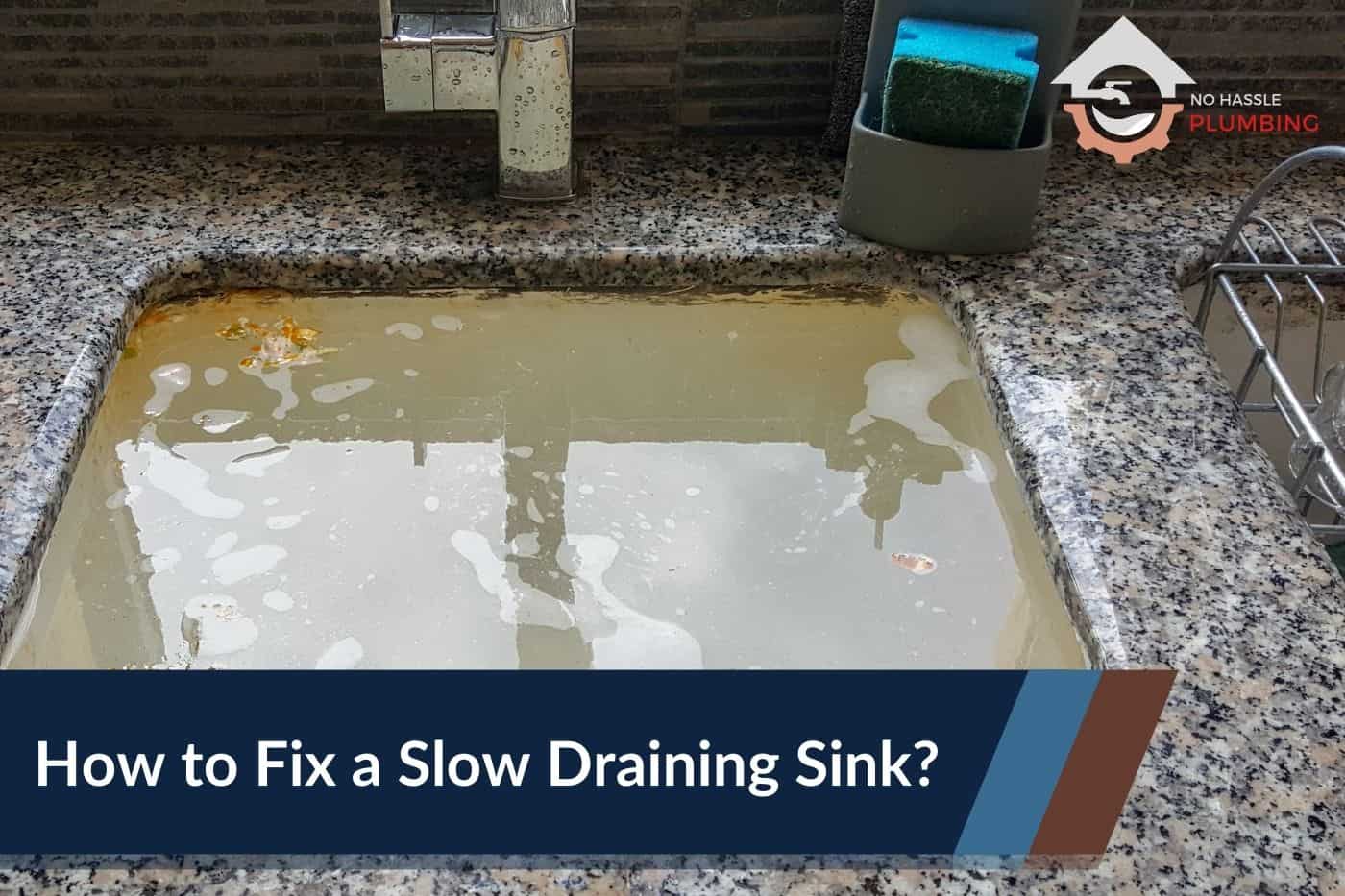A slow-draining sink is not a mere annoyance, but it can also be a warning sign of more significant plumbing problems. Ignoring it can lead to clogged pipes, water damage, and in some cases health hazards.
Before you call a plumber to unclog your sink, several home remedies for slow-draining sinks can do the trick. Based on our years of home callouts we’ll take you through nine different methods to solve the problem, explain why your sink drains slowly, and give some practical advice to prevent build-up and slow drainage.
Contents
How to Clear a Slow Drain 9 Different Ways
Cleaning a slow-draining sink is normally an easy and cheap fix with multiple different ways to tackle the issue.
| SKILL | COST | ESTIMATED TIME |
| Low – Moderate Most methods are straightforward, although snaking a drain takes a little more skill. | $0 TO $40, depending on what items you already have at home | Less than an hour |
If your sink drains slowly we’ve listed nine remedies to fix the problem below.
- Clean the Sink Stopper of Debris
- Use Homemade Drain Cleaners
- Use a Zip-It tool
- Use a Plunger
- Snake the Drain
- Check the Plumbing Trap
- Clean the Overflow Hole
- Check Your Vent Stack
- Use a Chemical Drain Cleaner
1. Clean the Sink Stopper of Debris
If you’re experiencing slow drainage, the issue might be your sink stopper or strainer basket. These components can become clogged with soap scum, toothpaste, food, hair, and other debris over time.
To resolve this problem, clean the stopper. Firstly, remove the stopper. In many modern sinks, you can simply unscrew it for easy access. For older sinks, a small rod with a nut and clip attached to the pipe beneath the sink must be removed to access the stopper.
Once you have removed the drain stopper, remove any larger objects and then scrub away any remaining soap scum or sludge that has accumulated with a brush, rag or paper towel. Once you’re happy that you’ve got it looking all shiny and new, give it a final rinse and screw it back in place.
2. Use Homemade Drain Cleaners
There are multiple DIY cleaners that can help clear a clogged sink drain, but the most popular is using two common household staples – baking soda and vinegar.
Remove any visible junk from the drain, and pour a half cup of baking soda followed by a half cup of white vinegar. This will cause a fizzy chemical reaction that should help to dislodge stuck gunk – let the mixture to work for an hour or two and then pour boiling water down the drain to flush any residue.
Using baking soda and vinegar is great for being cheap and easy to use, but it is unlikely to solve more problematic clogs.
3. Use a Plunger
A sink or sink plunger is a simple and affordable tool that can help you if your sink is draining slowly. It’s easy to use and can be used in a variety of situations, from minor clogs to major blockages.
To ensure a good seal, fill the sink basin with enough water so the rim of the plunger cup is submerged. Then start plunging up and down in quick, repetitive motions until the water starts draining away. This should dislodge any clogs that are causing the slow drainage, allowing for normal flow again.
4. Use a Zip-It tool
Zip-It tools are slim strips of plastic with hooks that are great for cleaning the drain of any hair and gunk trapped in your drainpipe. Simply thread it through your kitchen or bathroom drain and through the clog. Pull it out and the hooks will catch hair, or any other gunk blocking the pipe.
Alternatively, if the obstruction is visible, you can use a bent coat hanger to catch and remove any hair or debris buildup.
5. Snake the Drain
Plumbing snakes, also known as drain snakes or drain augers, can be an effective DIY solution to clean the pipe of deeper obstructions. These tools are long, flexible cables that can be inserted into the drain to break up and remove blockages.
To use a drain snake, insert the tip into the drain and rotate the handle. As you work the snake down the drain, you may feel resistance when it encounters the blockage. Keep rotating the handle or motor so the snake will push through the clog and break it up. Once you’ve cleared the blockage, run hot water down the drain to flush out any other debris.
While plumbing snakes can be effective for clearing clogs, it’s important to use them carefully to avoid damaging your pipes.
6. Check the Plumbing Trap
If all the above fails, the next thing you might be tempted to try on your bathroom sink is to remove and clean the p-trap. A plumbing trap is a U-shaped bend in the pipe below your sink, and is designed to hold standing water to prevent sewer gas from entering your home from the main sewer line. However, it also is a likely place for food, hair, and other detritus to get stuck.
Before you start, gather all the tools needed, make sure to turn off the water supply to the sink, and remove any items stored beneath it. Then, place a bucket underneath the P-trap to catch any dirty water that may come out.
The trap is usually held in place by slip nuts at each end of a curved section of pipe, so use a wrench to loosen these nuts and pull out the trap. You’ll likely find all sorts of debris inside it – coins, hair, and other gunk – which will block the flow of water from your sink.
Once you’ve removed all this sludge, replace the P-trap and tighten up the slip nuts to secure it back into place.
7. Clean the Overflow Hole
The overflow hole in your sink is a vital component for maintaining proper drainage. To ensure it functions optimally, regular cleaning is essential. Begin by locating and inspecting your sink’s overflow hole, which is typically situated near its rim.
To clean the overflow hole effectively, prepare a cleaning solution by mixing warm water with mild detergent or vinegar. You will need a small brush, such as an old toothbrush, for this task. Dip the brush into the cleaning mixture and gently insert it into the overflow hole. Use circular motions to dislodge any buildup or debris that may have accumulated over time.
Rinse the overflow hole thoroughly with clean water, continuing to scrub if necessary to remove any remaining residue. After completing the cleaning process, make sure to wipe away any excess moisture from the area surrounding the overflow hole to ensure it is completely dr
8. Check Your Vent Stack
Checking your vent stack is an important step in addressing slow-draining sinks. The vent stack, a vertical pipe that connects to your plumbing system, allows air to flow into the drain pipes, preventing vacuum and promoting efficient drainage. To check it, visually inspect the vent stack on your roof or exterior wall for any obstructions, such as debris or bird nests, and clear them if necessary.
9. Use a Chemical Drain Cleaner
If you are still having trouble with your bathroom or kitchen sink, you can try a store-bought drain cleaner. Commercially available chemical cleaners should dislodge built-up residue and grease but should be used with caution. The harsh chemicals can damage your plumbing system with repeated use. Make sure to follow the manufacturer’s instructions, and then flush the drain with very hot water.
Why is My Sink Not Draining Normally?
There are multiple reasons why your sink drain might be draining slowly. The most likely culprit is a blockage in the sink drain, or in the P-trap, which is the curved pipe that sits beneath the drain.
Over time, drains can become clogged with debris such as food, hair, soap scum and other items, preventing water from draining freely and causing it to become slow-moving or completely backed up. Add soap scum or grease to the mix, and you’re bound to get a ball of hard-to-shift gunk in your pipes.
How to Prevent Sinks Draining Slowly?
To help prevent these blockages, try to clean pipes and drains regularly by pouring baking soda and hot water down them. It’s also a good idea to cover bathroom drains with hair catchers and remove any potential impediments from the drains before they have the chance to disappear down your drain pipes.
You should also avoid pouring grease, oils, coffee grinds, or anything else that might become lodged or build up inside your plumbing.
Why is my Sink Still Draining Slowly Despite Not Being Clogged?
If your kitchen or bathroom sink still won’t drain, or you’re dealing with multiple slow drains, gurgling noises, sewer gas smells, or air bubbles, you might have a more serious issue like tree roots blocking your sewer line or a clogged vent pipe on your hands.
If you suspect this is the case, then the best solution is to call a qualified plumber who can help remedy the problem.

